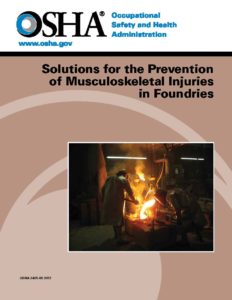
Ergonomic Solutions for Foundry Workers
Download the OSHA PDF • In the dynamic world of foundries, where molten metal transforms into custom castings, the intricate processes involved demand both precision and diligence. However, within this industrious realm, workers face various hazards that can impact their health and well-being. In this article, we delve into the Occupational Safety and Health Administration’s (OSHA) comprehensive publication addressing ergonomic solutions tailored specifically for foundry workers.
Understanding the Foundry Environment
Foundry work encompasses a series of meticulous tasks, including crafting casting patterns, assembling molds, refining molten metal, pouring it into molds, and meticulously cleaning the finished parts. The environment, though rich in craftsmanship, exposes workers to an array of potential hazards, ranging from chemical exposures to physical risks like dust, silica, lead, noise, heat stress, and gases.
Ergonomic Risks in Foundry Work
While various hazards demand attention, this publication from OSHA focuses primarily on the ergonomic risks prevalent among foundry workers. These include:
1. Exerting high levels of force to handle or move materials
2. Repetitive tasks leading to musculoskeletal disorders (MSDs)
3. Working in awkward postures
4. Prolonged maintenance of static body postures
5. Contact with sharp edges that can penetrate the skin
6. Exposure to vibrating tools and surfaces
Among foundry workers, injuries to the low back and upper limbs are unfortunately common MSDs. These can result from repetitive tasks, prolonged exertion of force, or the use of vibrating tools such as chipping hammers and rotary grinders. Early symptoms of MSDs include pain, restricted joint movement, swelling, numbness, and tingling, typically developing gradually over time due to intensive work.
OSHA’s Proactive Approach
To address these ergonomic challenges, OSHA collaborated with the Northeast Wisconsin Foundry Ergonomics Partnership (NEWFEP). This partnership involved visits to various foundries, each specializing in different products and employing diverse workforce sizes. The proactive implementation of ergonomic solutions resulted in a significant reduction in work-related MSDs among partnership members.
Benefits of Ergonomic Solutions
Companies that adopted ergonomic solutions witnessed a range of benefits, including:
- Substantial reduction in work-related MSDs
- Lower absenteeism rates
- Increased worker productivity and efficiency
- Improved product quality
Worker testimonials further underscored the positive impact of these solutions. In a safer and more comfortable work environment, employees reported experiencing less fatigue, thereby contributing to enhanced morale.
Bottom Line: Safety & Efficiency
In the pursuit of safety and efficiency, OSHA’s handbook on ergonomics for foundry workers serves as a valuable resource. By addressing the specific risks associated with this industry and providing practical solutions, the guide not only safeguards the health of workers but also contributes to the overall success and well-being of foundry operations. Embracing ergonomic principles is not just a regulatory requirement; it is a pathway to a safer, more productive, and harmonious foundry environment.
Thank you for joining us on this informative journey into foundry work environments. Stay tuned for more insights and tips!
Resources:
More Tools & Resources from Peak Ergonomics
Contact Us About Reducing Workplace Injuries
Healthy Employees are the Bottom Line! – Learn More!
